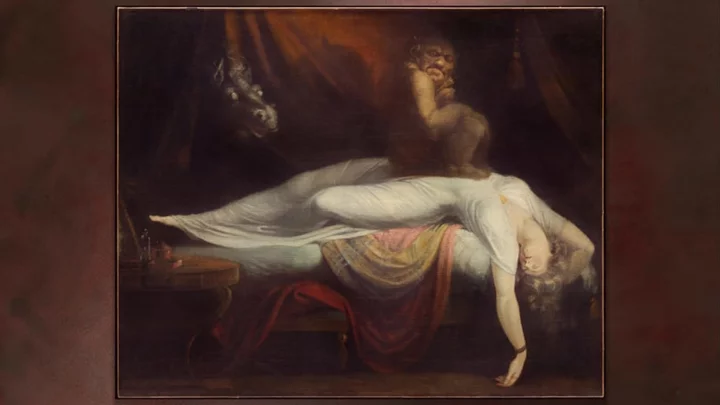Witches. Ghosts. Shadows. It wasn’t that long ago that dark paranormal forces seemed like the most plausible explanation for the strange phenomenon of sleep paralysis. After all, sufferers are not only trapped in their bodies and unable to move, but they’re usually subjected to terrifying hallucinations more vivid and stimulating than regular dreams.
Many of these hallucinations involve an unwelcome intruder metaphorically called a “sleep paralysis demon,” but historically, people took the “demon” part quite seriously. “The devil lay upon her and held her down,” wrote Dutch physician Isbrand van Diemerbroeck of a patient in 1644. Even doctors pointed to the fantastic back in the day.
Sleep paralysis happens when consciousness overlaps with the muscle atonia phase of REM sleep. In simpler terms, the brain is wide awake and lucid while the body is fast asleep. Like sleepwalking, sleep paralysis is classified as a parasomnia, or a sleep disorder accompanied by bizarre, usually undesirable physical activity or experiences. Before coherent medical explanations were available, different cultures used their own folklore and cultural beliefs to figure out what was happening. Take a look at these 13 names from across the world that describe sleep paralysis and the demon once believed to cause it.
1. Mære
Before time and hyperbole watered down the term, nightmare once referred to the nocturnal torture sleepers experienced at the hands of a malicious spirit called a mære. This Old English word only has debatable connections to adult female horses. According to Etymology Online, it likely derives from the Proto-Indo-European root mer- meaning “to harm” and refers to a (typically female) demon who paralyzes sleepers and suffocates them. This suffocation is one of the hallmarks of sleep paralysis across cultures, and it’s often believed to be the mære riding or sitting on people for sinister pleasure, making this phantasmagoric being closely related to succubi.
Mære and its many linguistic variants (mara in Old Norse, mare in Old Dutch, and mora in many Slavic languages) have given way to other modern words for “nightmare,” like the French cauchemar and the Dutch nachtmerrie. Given that sleep paralysis describes the liminal space between waking and dreams, the word mære may also relate to the Old Norse -mæri, which meant “borderland.”
2. Hexendrücken
When in doubt, blame the witches: That was the go-to ethos for many cultures to explain away any unfortunate event. Hexendrücken is a fun-to-say German word that translates to “witch’s pressing” and pinned the blame on evil enchantresses for the suffering of sleepers. This tradition would continue through the Salem Witch trials, leading to multiple deaths after people complained of being physically oppressed in the night by accused witches. Fun fact: In Germany, non-paralysis bad dreams are blamed on elves to this day. Their German word for a nightmare is Alptraum, or “elf-dream.”
3. Ogun Oru
Among the Yoruba of southwest Nigeria, ogun oru means “nocturnal warfare” and is seen as a type of demonic invasion of the body and mind. It’s characterized not just by the frightening loss of muscle control, but also as an epic battle between the sufferer’s spouse on Earth and their “spiritual” spouse that can only be fixed through exorcisms and Christian prayer.
4. Kanashibari
This Japanese word for sleep paralysis translates as “bound in metal,” combining the words kana (“metal”) and shibaru (“to bind”). It comes from a medieval Japanese spell practiced by priests to immobilize or expel an assortment of cunning supernatural beings known as yokai from possessing people. Some of these sleep paralysis-inducing yokai include the shapeshifting fox kitsune, a type of prankster zashiki-warashi (“child ghost”) known as a makuragaeshi, and the popular raccoon-like dog and trickster tanuki that has magical testicles (yes, you read that right).
5. Se me subió el muerto
In Mexico, this macabre folk expression means “a dead body climbed on top of me” and describes the uncanny horror of feeling suppressed by a mysterious and sinister weight. The shadows and figures that are often hallucinated during episodes are believed to be spirits of the deceased that lay on top of the sleeper, leaving them pinned to the bed, unable to get up.
6. Old Hag
Found across Britain and the Americas, and in particular Canada’s Newfoundland province, old hag is one of the most common colloquialisms for sleep paralysis. The old hag (who is sometimes called “night hag”) expands on the persistent witch mythology where a withered crone perches on top of the sleeper’s chest and holds them down.
7. Karabasan
Karabasan is a creature of Turkish folklore whose name means “the dark assailer” or “the dark presser.” Like many other terms, it can refer to both the state of paralysis as well as the seemingly supernatural spirit that descends upon sleepers, hovering over them and preying on fears. The name is derived from the words kara (“black”) and basmak (“to press” or “to overwhelm”), which seems fitting for a spirit that creeps up on sleepers at night to choke them senseless or steal their breath.
8. Pan Ephialtes
First the famed 2nd century Greek physician Galen used the word ephialtes (“jumping on you”) to describe sleep paralysis. Then Byzantine physician Paulus Aegineta one-upped him in the 7th century CE and called it “pan ephialtes.” Aegineta thought the terrifying state was the dirty work of the trickster Pan, god of the wild, companion of nymphs, player of annoying panpipes. Pan was believed to terrorize humans for laughs, hence the origin of the word panic, so needless to say that trampling on helpless people while they slept is pretty on-brand for the faun-like god.
9. Popobawa
The popobawa is an evil spirit from the Tanzanian archipelago of Zanzibar that is said to sexually assault its victims. Its name means “bat-wing” in Swahili, and it’s apparently a reference to the shadow cast by the spirit, which is a shapeshifter that can take on any form. It first appeared in the mid-1960s on the island of Pemba after a political revolution; widespread belief in the nocturnal phantom led to a collective panic in 1995 that culminated in murder. Zanzibar was a melting pot of colonizers and traders, and many argue that the Zanzibari incubus is a postmodern delusion that articulates horrors committed during slavery and blends together multiple cultural myths. Victims are urged to talk about the popobawa’s assaults or suffer repeat visits.
10. Gawi nulim (가위눌림)
Arguably the best entry on the list by virtue of its glorious literalness, this Korean expression is derived from gawi, meaning “nightmare, incubus,” and nulida, meaning “to be pressed down.” Like in many cultures, this is often believed to be the dark handiwork of a restless ghost.
11. Uqumangirniq
This Inuit term from Canada’s Baffin Island refers to an attack by shamans or malevolent spirits while a person was sleeping, when it was thought that their soul was vulnerable. The word aqtuqsinniq from the Kivalliq region, northwest of Hudson Bay, describes a similar phenomenon.
12. Pisadeira
Back sleepers beware. Pisadeira is a particularly ragged, long-fingernailed crone originating in southwestern Brazil, and her name means “she who steps.” Gaunt and unkempt (except in Afro-Brazilian lore where she is described as large and heavy), Pisadeira lurks on rooftops and attacks those who go to sleep belly up after particularly indulgent meals. She is believed to have evolved in part from a Portuguese myth of a red-capped friar who entered homes through the keyhole, placed his hand on the sleeper’s chest, and tortured his victims. The rest of her origin story may derive from tales of the Tupi people about a malevolent old woman who wouldn’t let people sleep.
13. Pesanta
Pesanta is an enormous demon dog from Catalan folklore that might occasionally appear as a cat, just to mix things up. With legs of iron and black fur as thick as lead, this mystical beast likes to lie down on you when it isn’t supposed to, just like your own house pets—but unlike your house pets, it dwells in churches and ruins and can walk through walls to break into your house. Hilariously, Pesanta’s paws are full of holes, so it can crush you while you sleep, but it won’t steal your stuff.
This article was originally published on www.mentalfloss.com as 13 Names for the Sleep Paralysis Demon from Around the World.









